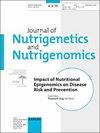现代健康流行病的营养问题和解决方案。
Q Agricultural and Biological Sciences
Journal of Nutrigenetics and Nutrigenomics
Pub Date : 2014-01-01
Epub Date: 2015-03-04
DOI:10.1159/000375471
引用次数: 8
摘要
本文章由计算机程序翻译,如有差异,请以英文原文为准。
Nutritional problems and solutions for the modern health epidemic.
Over the last few decades, the incidence and prevalence of chronic diseases – particularly obesity, diabetes, and cancer – has continued to rise, affecting hundreds of millions of people around the world. Since the 1980s, for instance, the incidence of diabetes in the United States has increased by 133% [1] , while worldwide obesity has more than doubled [2] . The growing threat of chronic diseases to global health calls for more effective measures to stop the health epidemic. To this end, the root causes must be addressed. Although many factors may be involved, ranging from genetics to lifestyle, chronic disease is very much a matter of disordered metabolism, which can be profoundly affected by the nutrients we eat. The association of chronic disease with nutrient metabolism points to the possibility of certain dietary or nutritional factors as underlying causes of today’s health epidemic. In my opinion, any dietary factors considered as the causes should satisfy two key criteria: (1) a shift (increase or decrease) in the intake of the particular nutrients correlates with an increase in the prevalence of chronic disease, and (2) the nutrients play a determining role in the key pathological processes, such as chronic low-grade inflammation and increased lipogenesis, that are the common mechanisms for chronic diseases. The Bellagio Report by Simopoulos et al. [3] and the latest update published in this issue [4] highlight two potential causes that may account for the upward trend of chronic disease incidence and prevalence during the last century. The first cause may be an increase in the dietary intake of omega-6 fatty acids and a decrease in the dietary intake of omega-3 fatty acids. These changes in omega-6 and omega-3 fatty acid intake have dramatically shifted the omega-6/omega-3 fatty acid ratio in both our diet and bodies from the human evolutionary ratio of ∼ 1: 1 to the modern dietary ratio ranging from 10: 1 to 50: 1, due to the industrialization of agriculture, processed foods, grain-fed livestock, and the increased consumption of vegetable oils [5] . This shift in the omega-6/omega-3 ratio has profound implications on human health, as these two classes of essential fatty acids are key components of cellular Published online: March 4, 2015
求助全文
通过发布文献求助,成功后即可免费获取论文全文。
去求助
来源期刊

Journal of Nutrigenetics and Nutrigenomics
GENETICS & HEREDITY-NUTRITION & DIETETICS
CiteScore
1.86
自引率
0.00%
发文量
0
审稿时长
>12 weeks
期刊介绍:
The emerging field of nutrigenetics and nutrigenomics is rapidly gaining importance, and this new international journal has been established to meet the needs of the investigators for a high-quality platform for their research. Endorsed by the recently founded "International Society of Nutrigenetics/Nutrigenomics", the ‘Journal of Nutrigenetics and Nutrigenomics’ welcomes contributions not only investigating the role of genetic variation in response to diet and that of nutrients in the regulation of gene expression, but is also open for articles covering all aspects of gene-environment interactions in the determination of health and disease.
 求助内容:
求助内容: 应助结果提醒方式:
应助结果提醒方式:


